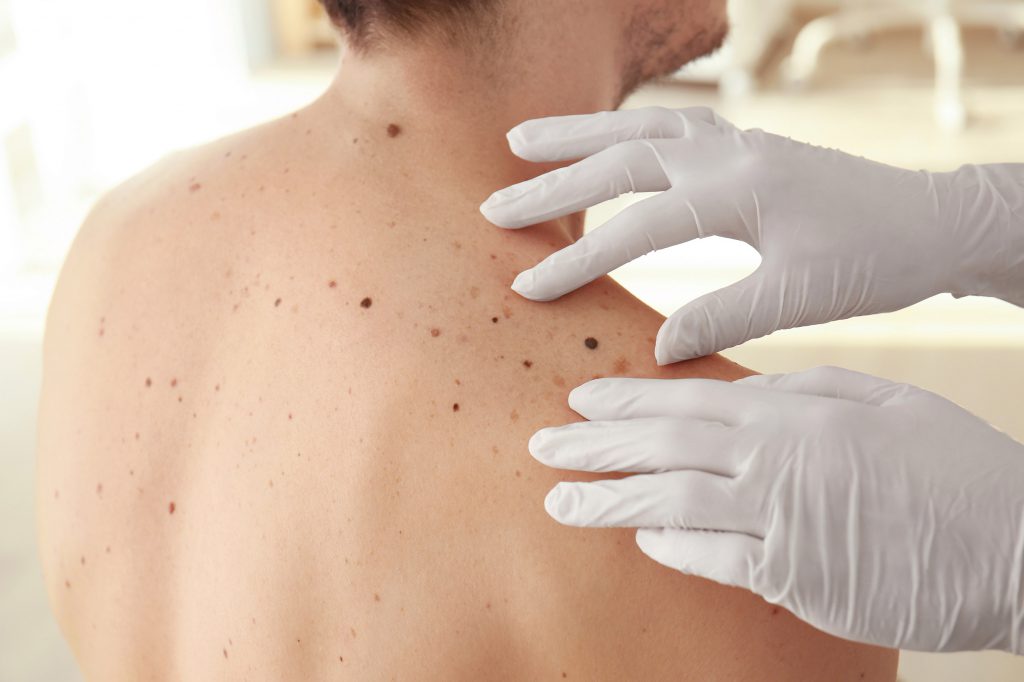Types of skin cancer

Incidences of skin cancer have doubled in Spain in the last three decades. There are around 4,000 cases of melanoma per year, and over 74,000 cases of other types of skin cancer. The trend suggests that these chilling figures will increase if appropriate skin protection and screening habits are not followed. But do we really understand what skin cancer is and the different types that exist?
Two main subtypes of skin cancer can be distinguished: melanoma and carcinoma. Melanoma is the most widely known and dangerous due to its high mortality rate. Carcinomas are divided into basal cell and squamous cell carcinomas.
Basal cell carcinoma
Basal cell carcinoma is the most common malignant tumour in humans. It tends to grow locally and slowly within the tissue where it is found. It is not able to metastasise and spread to other organs. It is characterized by its nodular shape and pearly shine, and sometimes presents a kind of crust or ulcer on its surface.
The main risk factor for its appearance is sunburn produced by intense and sporadic sun exposure (especially in childhood and adolescence). For this reason, it is very common to find it on the head and neck areas.
Its diagnosis is usually achieved via a clinical exploration conducted by a dermatologist. However, in some doubtful cases or when a complete surgical reconstruction is being evaluated, a biopsy may be necessary.
In most instances treatment will be surgical, except when the cancer is located very superficially in which case other therapeutic techniques can be used, such as liquid nitrogen cryotherapy, prescription creams such as imiquimod, or photodynamic therapies.
Squamous cell carcinoma
This type of skin cancer is the second most common malignant skin tumour and usually affects older people as well as immunosuppressed patients.
Unlike basal cell carcinoma, the main risk factor for its appearance is chronic sun exposure.
Precursor lesions, known as actinic keratoses, are very common and a key reason for dermatological check-ups. These are scratchy wounds with a scaly appearance that usually appear on the head, scalp, neck and hands.
When this type of carcinoma appears, it is in the form of an ulcerous nodule or tumour and may form a crust that often bleeds. These symptoms indicate the person is indeed suffering from a more invasive squamous cell carcinoma.
The treatment is usually surgical, except in cases where the tumour’s superficial location may allow for liquid nitrogen cryotherapy, imiquimod cream or photodynamic therapy.
Melanoma
Melanoma is the most dangerous type of skin tumour and is derived from a skin cell called melanocyte. Special care must be taken with these types of lesions as they are responsible for the highest number of deaths from skin cancer. Melanomas have the capacity to produce metastasis in other organs, which is why early diagnosis is so important.
The fundamental risk factor is sunburn during early childhood, which is why extreme precautions must be taken to avoid sunburn in children.
In addition, a family history of skin cancer (especially melanoma) and intense and intermittent sun exposure are risk factors.
Clinically, melanoma will appear as an irregular mole, an atypical pigmented lesion that dermatologists catalogue using the ABCDE standard:
- A – Asymmetry in one of its axes.
- B – Borders are irregular.
- C – Colours are varied.
- D – Diameter greater than 6mm.
- E – Evolution or changes in the mole such as itching, crusting or bleeding.
The diagnosis is usually made on the basis of a biopsy. Special attention should be paid to the Breslow index, which is the depth at which these cells are found in the skin. The deeper the skin, the worse the prognosis. Nowadays, a lot of importance is also given to the rate of cell mitosis (cell division) per square millimetre, and the presence of skin ulceration.
Melanoma treatment is fundamentally surgical and must respect adequate margins that are protocolised according to the depth of the tumour itself. It is very important to explore the lymph node chains and to perform a selective node biopsy that can drain the melanoma. All nodes in the tumour drainage vicinity should be removed.
Newer treatments, such as immunotherapy, are also being used to eliminate advanced melanoma.




